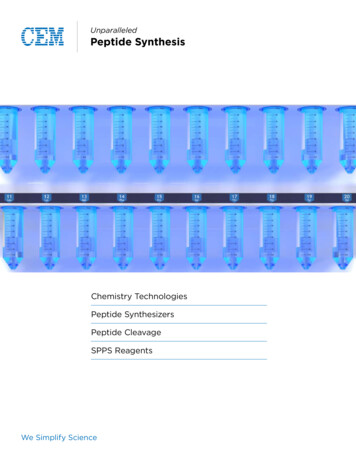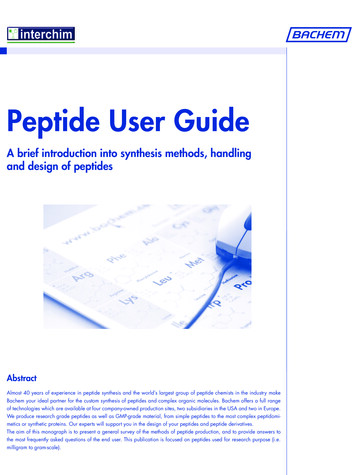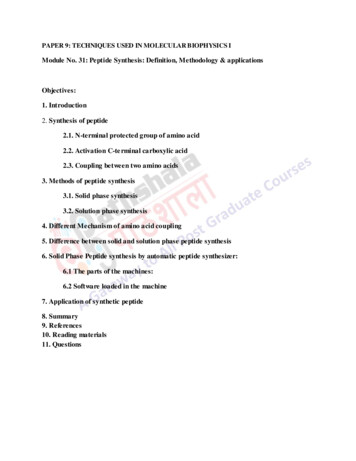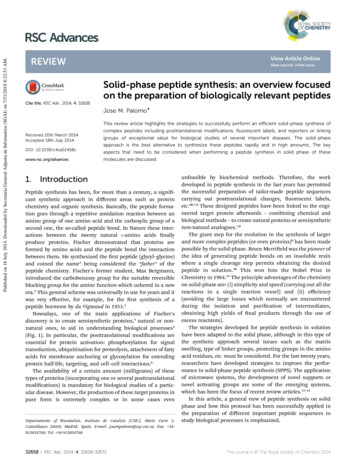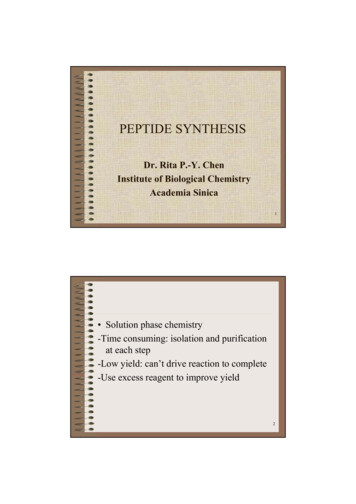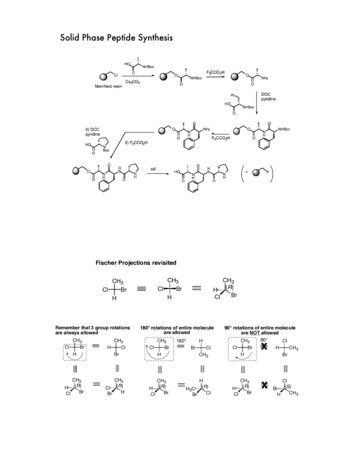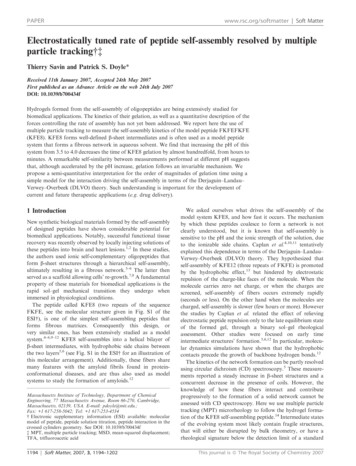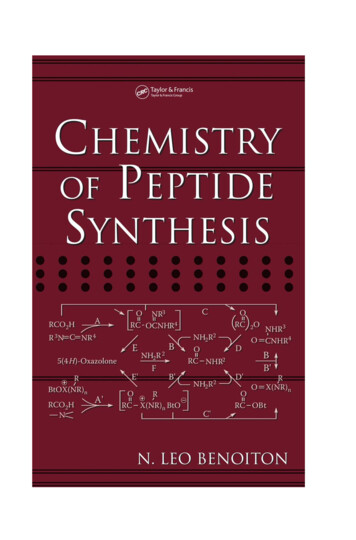
Transcription
CHEMISTRYOF PEPTIDESYNTHESISN. Leo BenoitonUniversity of OttawaOttawa, Ontario, CanadaBoca Raton London New York SingaporeA CRC title, part of the Taylor & Francis imprint, a member of theTaylor & Francis Group, the academic division of T&F Informa plc. 2006 by Taylor & Francis Group, LLC
DK3236 Discl.fm Page 1 Wednesday, June 8, 2005 2:56 PMPublished in 2006 byCRC PressTaylor & Francis Group6000 Broken Sound Parkway NW, Suite 300Boca Raton, FL 33487-2742 2006 by Taylor & Francis Group, LLCCRC Press is an imprint of Taylor & Francis GroupNo claim to original U.S. Government worksPrinted in the United States of America on acid-free paper10 9 8 7 6 5 4 3 2 1International Standard Book Number-10: 1-57444-454-9 (Hardcover)International Standard Book Number-13: 978-1-57444-454-4 (Hardcover)Library of Congress Card Number 2005005753This book contains information obtained from authentic and highly regarded sources. Reprinted material isquoted with permission, and sources are indicated. A wide variety of references are listed. Reasonable effortshave been made to publish reliable data and information, but the author and the publisher cannot assumeresponsibility for the validity of all materials or for the consequences of their use.No part of this book may be reprinted, reproduced, transmitted, or utilized in any form by any electronic,mechanical, or other means, now known or hereafter invented, including photocopying, microfilming, andrecording, or in any information storage or retrieval system, without written permission from the publishers.For permission to photocopy or use material electronically from this work, please access www.copyright.com(http://www.copyright.com/) or contact the Copyright Clearance Center, Inc. (CCC) 222 Rosewood Drive,Danvers, MA 01923, 978-750-8400. CCC is a not-for-profit organization that provides licenses and registrationfor a variety of users. For organizations that have been granted a photocopy license by the CCC, a separatesystem of payment has been arranged.Trademark Notice: Product or corporate names may be trademarks or registered trademarks, and are used onlyfor identification and explanation without intent to infringe.Library of Congress Cataloging-in-Publication DataBenoiton, N. Leo.Chemistry of peptide synthesis / N. Leo Benoiton.p. ; cm.Includes bibliographical references.ISBN-13: 978-1-57444-454-4 (hardcover : alk. paper)ISBN-10: 1-57444-454-9 (hardcover : alk. paper)1. Peptides--Synthesis.[DNLM: 1. Peptide Biosynthesis. QU 68 B456c 2005] I. Title.QP552.P4B46 2005612'.015756--dc222005005753Visit the Taylor & Francis Web site athttp://www.taylorandfrancis.comTaylor & Francis Groupis the Academic Division of T&F Informa plc. 2006 by Taylor & Francis Group, LLCand the CRC Press Web site athttp://www.crcpress.com
DK3236 C000.fm Page iii Tuesday, June 28, 2005 8:32 AMDedicationThis book is dedicated to Rao Makineni, a unique memberand benefactor of the peptide community. 2006 by Taylor & Francis Group, LLC
DK3236 C000.fm Page v Tuesday, June 28, 2005 8:32 AMPrefaceThis book has emerged from courses that I taught to biochemistry students at theundergraduate and graduate levels, to persons with a limited knowledge of organicchemistry, to chemists with experience in other fields, and to peptide chemists. Itassumes that the reader possesses a minimum knowledge of organic and amino-acidchemistry. It comprises 188 self-standing sections that include 207 figures writtenin clear language, with limited use of abbreviations. The focus is on understandinghow and why reactions and phenomena occur. There are a few tables of illustrativedata, but no tables of compounds or reaction conditions. The material is presentedprogressively, with some repetition, and then with amplification after the basics havebeen dealt with. The fundamentals of peptide synthesis, with an emphasis on theintermediates that are encountered in aminolysis reactions, are presented initially.The coupling of Nα-protected amino acids and Nα-protected peptides and theirtendencies to isomerize are then addressed separately. This allows for easier comprehension of the issues of stereomutation and the applicability of coupling reactions.Protection of functional groups is introduced on the basis of the methods that areemployed for removal of the protectors. A chapter is devoted to the question ofstereomutation, which is now more complex, following the discovery that Nαprotected amino acids can also give rise to oxazolones. Other chapters are devotedto solid-phase synthesis, side-chain protection and side reactions, amplification oncoupling methods, and miscellaneous topics. Points to note are that esters thatundergo aminolysis are referred to as activated esters, which is why they react, andnot active esters, and that in two cases two abbreviations (Z and Cbz; HOObt andHODhbt) are used haphazardly for one entity because that is the reality of the peptideliterature. An effort has been made to convey to the reader a notion of how the fieldof peptide chemistry has developed. To this end, the references are located at theend of each section and include the titles of articles. Most references have beenselected on the basis of the main theme that the chapter addresses. When therelevance of a paper is not obvious from the title, a phrase has been inserted inparentheses. The titles of papers written in German and French have been translated.For obvious reasons the number of references had to be limited. I extend myapologies to anyone who considers his or her work to have been unjustifiably omitted.Some poetic license was exercised in the creation of the manuscript and the reactionschemes. Inclusion of all details and exceptions to statements would have made thewhole too unruly.I am greatly indebted to Dr. Brian Ridge of the School of Chemical and Biological Sciences of the University of Exeter, United Kingdom, for his critical reviewof the manuscript and for his suggestions that have been incorporated into themanuscript. I solely am responsible for the book’s contents. I thank Professor JohnCoggins of the University of Glasgow for providing the references for Appendix 3, 2006 by Taylor & Francis Group, LLC
DK3236 C000.fm Page vi Tuesday, June 28, 2005 8:32 AMand I am grateful to anyone who might have provided me with information thatappears in this book. I am grateful to the University of Ottawa for the office andlibrary services that have been provided to me. I am indebted to Dr. Rao Makinenifor generous support provided over the years. I thank the publishers for their patienceduring the long period when submission of the manuscript was overdue. And mostimportant, I thank my wife Ljuba for her patience and support and express mysincere apologies for having deprived her of the company of her “retired” husbandfor a period much longer than had been planned. 2006 by Taylor & Francis Group, LLC
DK3236 C000.fm Page vii Tuesday, June 28, 2005 8:32 AMTable of ContentsChapter 151.161.171.181.191.201.211.22Chemical and Stereochemical Nature of Amino Acids .1Ionic Nature of Amino Acids .2Charged Groups in Peptides at Neutral pH.3Side-Chain Effects in Other Amino Acids .4General Approach to Protection and Amide-Bond Formation.5N-Acyl and Urethane-Forming N-Substituents .6Amide-Bond Formation and the Side Reaction ofOxazolone Formation.7Oxazolone Formation and Nomenclature.8Coupling, 2-Alkyl-5(4H)-Oxazolone Formation and Generation ofDiastereoisomers from Activated Peptides .9Coupling of N-Alkoxycarbonylamino Acids without Generation ofDiastereoisomers: Chirally Stable 2-Alkoxy-5(4H)-Oxazolones.10Effects of the Nature of the Substituents on the Amino andCarboxyl Groups of the Residues That Are Coupled toProduce a Peptide.11Introduction to Carbodiimides and Substituted Ureas .12Carbodiimide-Mediated Reactions of N-Alkoxycarbonylamino Acids .12Carbodiimide-Mediated Reactions of N-Acylamino Acids and Peptides.13Preformed Symmetrical Anhydrides of N-Alkoxycarbonylamino Acids.14Purified Symmetrical Anhydrides of N-Alkoxycarbonylamino AcidsObtained Using a Soluble Carbodiimide.15Purified 2-Alkyl-5(4H)-Oxazolones from N-Acylamino andN-Protected Glycylamino Acids .162-Alkoxy-5(4H)-Oxazolones as Intermediates in Reactions ofN-Alkoxycarbonylamino Acids.17Revision of the Central Tenet of Peptide Synthesis.18Strategies for the Synthesis of Enantiomerically Pure Peptides.19Abbreviated Designations of Substituted Amino Acids and Peptides .20Literature on Peptide Synthesis .21Chapter 22.12.22.3Fundamentals of Peptide Synthesis .1Methods for the Formation of Peptide Bonds.25Coupling Reagents and Methods and Activated Forms .25Peptide-Bond Formation from Carbodiimide-Mediated Reactions ofN-Alkoxycarbonylamino Acids.26Factors Affecting the Course of Events in Carbodiimide-MediatedReactions of N-Alkoxycarbonylamino Acids .28 2006 by Taylor & Francis Group, LLC
DK3236 C000.fm Page viii Tuesday, June 28, 2005 8:32 172.182.192.202.212.22Intermediates and Their Fate in Carbodiimide-Mediated Reactions ofN-Alkoxycarbonylamino Acids.29Peptide-Bond Formation from Preformed Symmetrical Anhydrides ofN-Alkoxycarbonylamino Acids.30Peptide-Bond Formation from Mixed Anhydrides ofN-Alkoxycarbonylamino Acids.32Alkyl Chloroformates and Their Nomenclature.34Purified Mixed Anhydrides of N-Alkoxycarbonylamino Acids andTheir Decomposition to 2-Alkoxy-5(4H)-Oxazolones.34Peptide-Bond Formation from Activated Esters ofN-Alkoxycarbonylamino Acids.36Anchimeric Assistance in the Aminolysis of Activated Esters .38On the Role of Additives as Auxiliary Nucleophiles:Generation of Activated Esters .391-Hydroxybenzotriazole as an Additive That Suppresses N-AcylureaFormation by Protonation of the O-Acylisourea.40Peptide-Bond Formation from Azides ofN-Alkoxycarbonylamino Acids.41Peptide-Bond Formation from Chlorides ofN-Alkoxycarbonylamino Acids:N-9-Fluorenylmethoxycarbonylamino-Acid Chlorides .43Peptide-Bond Formation from ated Reactions ofN-Alkoxycarbonylamino Acids.44Coupling Reagents Composed of an Additive Linked to aCharged Atom Bearing Dialkylamino Substituents and aNonnucleophilic Counter-Ion.45Peptide-Bond Formation from mHexafluorophosphate-Mediated Reactions ofN-Alkoxycarbonylamino Acids.46Peptide-Bond Formation roniumHexafluorophosphate- and Tetrafluoroborate-MediatedReactions of N-Alkoxycarbonylamino Acids .48Pyrrolidino Instead of Dimethylamino Substituents for theEnvironmental Acceptability of Phosphonium and CarbeniumSalt-Based Reagents.50Intermediates and Their Fate in Benzotriazol-1-ylOxyphosphonium and Carbenium Salt-Mediated Reactions .511-Hydroxybenzotriazole as Additive in Couplings ofN-Alkoxycarbonylamino Acids Effected by Phosphonium andUronium Salt-Based Reagents .53Some Tertiary Amines Used as Bases in Peptide Synthesis.54 2006 by Taylor & Francis Group, LLC
DK3236 C000.fm Page ix Tuesday, June 28, 2005 8:32 AM2.23 The Applicability of Peptide-Bond Forming Reactions to theCoupling of N-Protected Peptides Is Dictated by the Requirementto Avoid Epimerization: 5(4H)-Oxazolones from Activated Peptides .562.24 Methods for Coupling N-Protected Peptides.572.25 On the Role of 1-Hydroxybenzotriazole as an EpimerizationSuppressant in Carbodiimide-Mediated Reactions.602.26 More on Additives.612.27 An Aid to Deciphering the Constitution of Coupling Reagents fromTheir Abbreviations.63Chapter 153.163.173.183.193.20The Nature and Properties Desired of Protected Amino Acids .65Alcohols from Which Protectors Derive and TheirAbbreviated Designations .66Deprotection by Reduction: Hydrogenolysis .67Deprotection by Reduction: Metal-Mediated Reactions .68Deprotection by Acidolysis: Benzyl-Based Protectors .69Deprotection by Acidolysis: tert-Butyl-Based Protectors .71Alkylation due to Carbenium Ion Formation during Acidolysis .72Deprotection by Acid-Catalyzed Hydrolysis.73Deprotection by Base-Catalyzed Hydrolysis.73Deprotection by beta-Elimination .74Deprotection by beta-Elimination: 9-Fluorenylmethyl-BasedProtectors.76Deprotection by Nucleophilic Substitution by Hydrazineor Alkyl Thiols .77Deprotection by Palladium-Catalyzed Allyl Transfer .78Protection of Amino Groups: Acylation and Dimer Formation. 79Protection of Amino Groups: Acylation without Dimer Formation .80Protection of Amino Groups: tert-Butoxycarbonylation.82Protection of Carboxyl Groups: Esterification .83Protection of Carboxyl, Hydroxyl, and Sulfhydryl Groups bytert-Butylation and Alkylation .86Protectors Sensitized or Stabilized to Acidolysis.87Protecting Group Combinations .90Chapter 44.14.24.34.4Protectors and Methods of Deprotection.65Chirality in Peptide Synthesis .93Mechanisms of Stereomutation: Acid-Catalyzed Enolization .93Mechanisms of Stereomutation: Base-Catalyzed Enolization .94Enantiomerization and Its Avoidance during Couplings ofN-Alkoxycarbonyl-L-Histidine .95Mechanisms of Stereomutation: Base-Catalyzed Enolization ofOxazolones Formed from Activated Peptides .97 2006 by Taylor & Francis Group, LLC
DK3236 C000.fm Page x Tuesday, June 28, 2005 8:32 .184.194.204.214.224.234.24Mechanisms of Stereomutation: Base-Induced Enolization ofOxazolones Formed from Activated N-Alkoxycarbonylamino Acids .98Stereomutation and Asymmetric Induction .99Terminology for Designating Stereomutation .101Evidence of Stereochemical Inhomogeneity in Synthesized Products.102Tests Employed to Acquire Information on Stereomutation.103Detection and Quantitation of Epimeric Peptides byNMR Spectroscopy .105Detection and Quantitation of Epimeric Peptides by HPLC .106External Factors That Exert an Influence on the Extent ofStereomutation during Coupling.107Constitutional Factors That Define the Extent of Stereomutationduring Coupling: Configurations of the Reacting Residues .108Constitutional Factors That Define the Extent of Stereomutationduring Coupling: The N-Substituent of the Activated Residue or thePenultimate Residue.109Constitutional Factors That Define the Extent of Stereomutationduring Coupling: The Aminolyzing Residue and ItsCarboxy Substituent.110Constitutional Factors That Define the Extent of Stereomutationduring Coupling: The Nature of the Activated Residue .112Reactions of Activated Forms of N-Alkoxycarbonylamino Acidsin the Presence of Tertiary Amine .113Implications of Oxazolone Formation in the Couplings ofN-Alkoxycarbonlyamino Acids in the Presence of Tertiary Amine .115Enantiomerization in 4-Dimethylaminopyridine-Assisted Reactions ofN-Alkoxycarbonylamino Acids.115Enantiomerization during Reactions of ActivatedN-Alkoxycarbonylamino Acids with Amino Acid Anions.117Possible Origins of Diastereomeric Impurities in Synthesized Peptides.118Options for Minimizing Epimerization during the Couplingof Segments.119Methods for Determining Enantiomeric Content.120Determination of Enantiomers by Analysis of DiastereoisomersFormed by Reaction with a Chiral Reagent.122Chapter 55.15.25.35.45.55.65.75.8Solid-Phase Synthesis .125The Idea of Solid-Phase Synthesis .125Solid-Phase Synthesis as Developed by Merrifield .126Vessels and Equipment for Solid-Phase Synthesis .127A Typical Protocol for Solid-Phase Synthesis .129Features and Requirements for Solid-Phase Synthesis .131Options and Considerations for Solid-Phase Synthesis .132Polystyrene Resins and Solvation in Solid-Phase Synthesis .133Polydimethylacrylamide Resin .134 2006 by Taylor & Francis Group, LLC
DK3236 C000.fm Page xi Tuesday, June 28, 2005 8:32 .215.225.235.24Polyethyleneglycol-Polystyrene Graft Polymers.136Terminology and Options for Anchoring the First Residue .137Types of Target Peptides and Anchoring Linkages.139Protecting Group Combinations for Solid-Phase Synthesis .140Features of Synthesis Using Boc/Bzl Chemistry .140Features of Synthesis Using Fmoc/tBu Chemistry .141Coupling Reagents and Methods for Solid-Phase Synthesis .142Merrifield Resin for Synthesis of Peptides Using Boc/Bzl Chemistry .143Phenylacetamidomethyl Resin for Synthesis of Peptides UsingBoc/Bzl Chemistry.144Benzhydrylamine Resin for Synthesis of Peptide Amides UsingBoc/Bzl Chemistry.145Resins and Linkers for Synthesis of Peptides UsingFmoc/tBu Chemistry .146Resins and Linkers for Synthesis of Peptide Amides UsingFmoc/tBu Chemistry .147Resins and Linkers for Synthesis of Protected PeptideAcids and Amides .149Esterification of Fmoc-Amino Acids to HydroxymethylGroups of Supports .1512-Chlorotrityl Chloride Resin for Synthesis Using Fmoc/tBuChemistry .153Synthesis of Cyclic Peptides on Solid Supports .154Chapter 156.166.17Reactivity, Protection, and Side Reactions.157Protection Strategies and the Implications Thereof .157Constitutional Factors Affecting the Reactivity of Functional Groups .158Constitutional Factors Affecting the Stability of Protectors .159The ε-Amino Group of Lysine .160The Hydroxyl Groups of Serine and Threonine .162Acid-Induced O-Acylation of Side-Chain Hydroxyls and theO-to-N Acyl Shift.163The Hydroxyl Group of Tyrosine .165The Methylsulfanyl Group of Methionine .166The Indole Group of Tryptophan .167The Imidazole Group of Histidine .169The Guanidino Group of Arginine .170The Carboxyl Groups of Aspartic and Glutamic Acids.172Imide Formation from Substituted Dicarboxylic Acid Residues.174The Carboxamide Groups of Asparagine and Glutamine.176Dehydration of Carboxamide Groups to Cyano Groupsduring Activation.178Pyroglutamyl Formation from Glutamyl and Glutaminyl Residues.179The Sulfhydryl Group of Cysteine and the Synthesis of PeptidesContaining Cystine.181 2006 by Taylor & Francis Group, LLC
DK3236 C000.fm Page xii Tuesday, June 28, 2005 8:32 AM6.18 Disulfide Interchange and Its Avoidance during the Synthesis ofPeptides Containing Cystine.1836.19 Piperazine-2,5-Dione Formation from Esters of Dipeptides.1856.20 N-Alkylation during Palladium-Catalyzed HydrogenolyticDeprotection and Its Synthetic Application .1876.21 Catalytic Transfer Hydrogenation and the HydrogenolyticDeprotection of Sulfur-Containing Peptides .1886.22 Mechanisms of Acidolysis and the Role of Nucleophiles .1906.23 Minimization of Side Reactions during Acidolysis .1936.24 Trifunctional Amino Acids with Two Different Protectors.194Chapter 157.16.7.177.187.197.207.217.22Ventilation of Activated Forms and Coupling Methods.197Notes on Carbodiimides and Their Use .197Cupric Ion as an Additive That Eliminates Epimerization inCarbodiimide-Mediated Reactions .199Mixed Anhydrides: Properties and Their Use .200Secondary Reactions of Mixed Anhydrides: Urethane Formation .201Decomposition of Mixed Anhydrides:2-Alkoxy-5(4H)-Oxazolone Formation and Disproportionation.203Activated Esters: Reactivity.205Preparation of Activated Esters Using Carbodiimides andAssociated Secondary Reactions .206Other Methods for the Preparation of Activated Esters ofN-Alkoxycarbonylamino Acids.208Activated Esters: Properties and Specific Uses.209Methods for the Preparation of Activated Esters of Protected Peptides,Including Alkyl Thioesters.211Synthesis Using N-9-FluorenylmethoxycarbonylaminoAcid Chlorides .213Synthesis Using N-Alkoxycarbonylamino-Acid Fluorides .216Amino-Acid N-Carboxyanhydrides: Preparation and Aminolysis.218N-Alkoxycarbonylamino-Acid N-Carboxyanhydrides .220Decomposition during the Activation of Boc-Amino Acids andConsequent Dimerization.222Acyl Azides and the Use of Protected Hydrazides .224O-Acyl and N-Acyl N-Oxide Forms of 1-HydroxybenzotriazoleAdducts and the Uronium and Guanidinium Forms ofCoupling Reagents .226Phosphonium and Uronium/Aminium/GuanidiniumSalt-Based Reagents: Properties and Their Use.229Newer Coupling Reagents .230To Preactivate or Not to Preactivate: Should That Be the Question? .232Aminolysis of Succinimido Esters by Unprotected AminoAcids or Peptides .234Unusual Phenomena Relating to Couplings of Proline .235 2006 by Taylor & Francis Group, LLC
DK3236 C000.fm Page xiii Tuesday, June 28, 2005 8:32 AM7.23 Enantiomerization of the Penultimate Residue during Couplingof an Nα-Protected Peptide .2377.24 Double Insertion in Reactions of Glycine Derivatives: Rearrangementof Symmetrical Anhydrides to Peptide-Bond-Substituted Dipeptides.2387.25 Synthesis of Peptides by Chemoselective Ligation.2407.26 Detection and Quantitation of Activated Forms.242Chapter 8Miscellaneous.2458.1. Enantiomerization of Activated N-Alkoxycarbonylamino Acids andEsterified Cysteine Residues in the Presence of Base .2458.2 Options for Preparing N-Alkoxycarbonylamino AcidAmides and 4-Nitroanilides .2478.3 Options for Preparing Peptide Amides.2498.4 Aggregation during Peptide-Chain Elongation and Solventsfor Its Minimization .2518.5 Alkylation of Peptide Bonds to Decrease Aggregation:2-Hydroxybenzyl Protectors .2538.6 Alkylation of Peptide Bonds to Decrease Aggregation:Oxazolidines and Thiazolidines (Pseudo-Prolines) .2558.7 Capping and the Purification of Peptides.2568.8 Synthesis of Large Pept
to solid-phase synthesis, side-chain protection and side reactions, amplification on coupling methods, and miscellaneous topics. Points to note are that esters that undergo aminolysis are referred to as activated esters, which is why they react, and not active esters, and that in two cases two abbreviations (Z and Cbz; HOObt and
